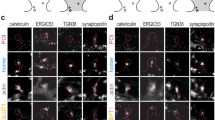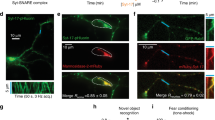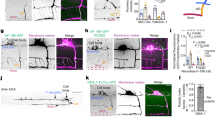Abstract
The neuronal secretory pathway represents the intracellular route for proteins involved in synaptic transmission and plasticity, as well as lipids required for outgrowth and remodelling of dendrites and axons. Although neurons use the same secretory compartments as other eukaryotic cells, the enormous distances involved, as well as the unique morphology of the neuron and its signalling requirements, challenge canonical models of secretory pathway organization. Here, we review evidence for a distributed secretory pathway in neurons, suggest mechanisms that may regulate secretory compartment distribution, and discuss the implications of a distributed secretory pathway for neuronal morphogenesis and neural-circuit plasticity.
This is a preview of subscription content, access via your institution
Access options
Subscribe to this journal
Receive 12 print issues and online access
$209.00 per year
only $17.42 per issue
Buy this article
- Purchase on Springer Link
- Instant access to full article PDF
Prices may be subject to local taxes which are calculated during checkout






Similar content being viewed by others
References
Golgi, C. Intorno alla struttura delle cellule nervose. Boll. Soc. Med. Chir. Pav. 13, 3–16 (1898).
Steward, O. & Schuman, E.M. Compartmentalized synthesis and degradation of proteins in neurons. Neuron 40, 347–359 (2003).
Job, C. & Eberwine, J. Localization and translation of mRNA in dendrites and axons. Nature Rev. Neurosci. 2, 889–898 (2001).
Deutsch, C. The birth of a channel. Neuron 40, 265–276 (2003).
Bichet, D. et al. The I-II loop of the Ca2+ channel α1 subunit contains an endoplasmic reticulum retention signal antagonized by the beta subunit. Neuron 25, 177–190 (2000).
Margeta-Mitrovic, M., Jan, Y.N. & Jan, L.Y. A trafficking checkpoint controls GABA(B) receptor heterodimerization. Neuron 27, 97–106 (2000).
Standley, S., Roche, K.W., McCallum, J., Sans, N. & Wenthold, R.J. PDZ domain suppression of an ER retention signal in NMDA receptor NR1 splice variants. Neuron 28, 887–898 (2000).
Scott, D.B., Blanpied, T.A., Swanson, G.T., Zhang, C. & Ehlers, M.D. An NMDA receptor ER retention signal regulated by phosphorylation and alternative splicing. J. Neurosci. 21, 3063–3072 (2001).
Mu, Y., Otsuka, T., Horton, A.C., Scott, D.B. & Ehlers, M.D. Activity-dependent mRNA splicing controls ER export and synaptic delivery of NMDA receptors. Neuron 40, 581–594 (2003).
Ma, D. et al. Role of ER export signals in controlling surface potassium channel numbers. Science 291, 316–319 (2001).
Barlowe, C. COPII-dependent transport from the endoplasmic reticulum. Curr. Opin. Cell Biol. 14, 417–422 (2002).
Hammond, A.T. & Glick, B.S. Dynamics of transitional endoplasmic reticulum sites in vertebrate cells. Mol. Biol. Cell 11, 3013–3030 (2000).
Stephens, D.J., Lin-Marq, N., Pagano, A., Pepperkok, R. & Paccaud, J.P. COPI-coated ER-to-Golgi transport complexes segregate from COPII in close proximity to ER exit sites. J. Cell Sci. 113, 2177–2185 (2000).
Horton, A.C. & Ehlers, M.D. Dual modes of endoplasmic-reticulum-to-Golgi transport in dendrites revealed by live-cell imaging. J. Neurosci. 23, 6188–6199 (2003).
Aridor, M., Guzik, A.K., Bielli, A. & Fish, K.N. Endoplasmic reticulum export site formation and function in dendrites. J. Neurosci. 24, 3770–3776 (2004).
Pelletier, L., Jokitalo, E. & Warren, G. The effect of Golgi depletion on exocytic transport. Nature Cell Biol. 2, 840–846 (2000).
Gardiol, A., Racca, C. & Triller, A. Dendritic and postsynaptic protein synthetic machinery. J. Neurosci. 19, 168–179 (1999).
Pierce, J.P., Mayer, T. & McCarthy, J.B. Evidence for a satellite secretory pathway in neuronal dendritic spines. Curr. Biol. 11, 351–355 (2001).
Torre, E.R. & Steward, O. Protein synthesis within dendrites: glycosylation of newly synthesized proteins in dendrites of hippocampal neurons in culture. J. Neurosci. 16, 5967–5978 (1996).
Kacharmina, J.E., Job, C., Crino, P. & Eberwine, J. Stimulation of glutamate receptor protein synthesis and membrane insertion within isolated neuronal dendrites. Proc. Natl Acad. Sci. USA 97, 11545–11550 (2000).
Ju, W. et al. Activity-dependent regulation of dendritic synthesis and trafficking of AMPA receptors. Nature Neurosci. 8, 8 (2004).
Sheffield, H.G. & Bjorvat, B. Ultrastructure of the cyst of Giardia lamblia. Am. J. Trop. Med. Hyg. 26, 23–30 (1977).
Reiner, D.S., Douglas, H. & Gillin, F.D. Identification and localization of cyst-specific antigens of Giardia lamblia. Infect. Immun. 57, 963–968 (1989).
Lujan, H.D. et al. Developmental induction of Golgi structure and function in the primitive eukaryote Giardia lamblia. J. Biol. Chem. 270, 4612–4618 (1995).
Pelletier, L. et al. Golgi biogenesis in Toxoplasma gondii. Nature 418, 548–552 (2002).
Lucocq, J.M., Warren, G. Fragmentation and partitioning of the Golgi apparatus during mitosis in HeLa cells. EMBO J. 6, 3239–3246 (1987).
Lucocq, J.M., Berger, E.G. & Warren, G. Mitotic Golgi fragments in HeLa cells and their role in the reassembly pathway. J. Cell Biol. 109, 463–474 (1989).
Seemann, J., Pypaert, M., Taguchi, T., Malsam, J. & Warren, G. Partitioning of the matrix fraction of the Golgi apparatus during mitosis in animal cells. Science 295, 848–851 (2002).
Shima, D.T., Cabrera-Poch, N., Pepperkok, R. & Warren, G. An ordered inheritance strategy for the Golgi apparatus: visualization of mitotic disassembly reveals a role for the mitotic spindle. J. Cell Biol. 141, 955–966 (1998).
Souter, E., Pypaert, M. & Warren, G. The Golgi stack reassembles during telophase before arrival of proteins transported from the endoplasmic reticulum. J. Cell Biol. 122, 533–540 (1993).
Lowe, M., Gonatas, N.K. & Warren, G. The mitotic phosphorylation cycle of the cis-Golgi matrix protein GM130. J. Cell Biol. 149, 341–356 (2000).
Fath, K.R., Trimbur, G.M. & Burgess, D.R. Molecular motors and a spectrin matrix associate with Golgi membranes in vitro. J. Cell Biol. 139, 1169–1181 (1997).
Seemann, J., Jokitalo, E., Pypaert, M. & Warren, G. Matrix proteins can generate the higher order architecture of the Golgi apparatus. Nature 407, 1022–1026 (2000).
Lippincott-Schwartz, J., Yuan, L.C., Bonifacino, J.S. & Klausner, R.D. Rapid redistribution of Golgi proteins into the ER in cells treated with brefeldin A: evidence for membrane cycling from Golgi to ER. Cell 56, 801–813 (1989).
Cole, N.B., Ellenberg, J., Song, J., DiEuliis, D. & Lippincott-Schwartz, J. Retrograde transport of Golgi-localized proteins to the ER. J. Cell Biol. 140, 1–15 (1998).
Lippincott-Schwartz, J., Roberts, T.H. & Hirschberg, K. Secretory protein trafficking and organelle dynamics in living cells. Annu. Rev. Cell Dev. Biol. 16, 557–589 (2000).
Rossanese, O.W. et al. Golgi structure correlates with transitional endoplasmic reticulum organization in Pichia pastoris and Saccharomyces cerevisiae. J. Cell Biol. 145, 69–81 (1999).
Thyberg, J. & Moskalewski, S. Role of microtubules in the organization of the Golgi complex. Exp. Cell Res. 246, 263–279 (1999).
Rogalski, A.A., Bergmann, J.E. & Singer, S.J. Effect of microtubule assembly status on the intracellular processing and surface expression of an integral protein of the plasma membrane. J. Cell Biol. 99, 1101–1109 (1984).
Ho, W.C., Allan, V.J., van Meer, G., Berger, E.G. & Kreis, T.E. Reclustering of scattered Golgi elements occurs along microtubules. Eur. J. Cell Biol. 48, 250–263 (1989).
Burkhardt, J.K., Echeverri, C.J., Nilsson, T. & Vallee, R.B. Overexpression of the dynamitin (p50) subunit of the dynactin complex disrupts dynein-dependent maintenance of membrane organelle distribution. J. Cell Biol. 139, 469–484 (1997).
Vaisberg, E.A., Grissom, P.M. & McIntosh, J.R. Mammalian cells express three distinct dynein heavy chains that are localized to different cytoplasmic organelles. J. Cell Biol. 133, 831–842 (1996).
Kupfer, A., Louvard, D. & Singer, S.J. Polarization of the Golgi apparatus and the microtubule-organizing center in cultured fibroblasts at the edge of an experimental wound. Proc. Natl Acad. Sci. USA 79, 2603–2607 (1982).
Etienne-Manneville, S. & Hall, A. Cdc42 regulates GSK-3β and adenomatous polyposis coli to control cell polarity. Nature 421, 753–756 (2003).
Baas, P.W., Deitch, J.S., Black, M.M. & Banker, G.A. Polarity orientation of microtubules in hippocampal neurons: uniformity in the axon and nonuniformity in the dendrite. Proc. Natl Acad. Sci. USA 85, 8335–8339 (1988).
Sharp, D.J., Yu, W. & Baas, P.W. Transport of dendritic microtubules establishes their nonuniform polarity orientation. J. Cell Biol. 130, 93–103 (1995).
Burack, M.A., Silverman, M.A. & Banker, G. The role of selective transport in neuronal protein sorting. Neuron 26, 465–472 (2000).
Presley, J.F. et al. ER-to-Golgi transport visualized in living cells. Nature 389, 81–85 (1997).
Fath, K.R., Trimbur, G.M. & Burgess, D.R. Molecular motors are differentially distributed on Golgi membranes from polarized epithelial cells. J. Cell Biol. 126, 661–675 (1994).
Musch, A., Cohen, D. & Rodriguez-Boulan, E. Myosin II is involved in the production of constitutive transport vesicles from the TGN. J. Cell Biol. 138, 291–306 (1997).
Buss, F. et al. The localization of myosin VI at the golgi complex and leading edge of fibroblasts and its phosphorylation and recruitment into membrane ruffles of A431 cells after growth factor stimulation. J. Cell Biol. 143, 1535–1545 (1998).
Johnston, G.C., Prendergast, J.A. & Singer, R.A. The Saccharomyces cerevisiae MYO2 gene encodes an essential myosin for vectorial transport of vesicles. J. Cell Biol. 113, 539–551 (1991).
Camera, P. et al. Citron-N is a neuronal Rho-associated protein involved in Golgi organization through actin cytoskeleton regulation. Nature Cell Biol. 5, 1071–1078 (2003).
Echard, A. et al. Interaction of a Golgi-associated kinesin-like protein with Rab6. Science 279, 580–585 (1998).
Harada, A. et al. Golgi vesiculation and lysosome dispersion in cells lacking cytoplasmic dynein. J. Cell. Biol. 141, 51–59 (1998).
Ghosh, P., Griffith, J., Geuze, H.J. & Kornfeld, S. Mammalian GGAs act together to sort mannose 6-phosphate receptors. J. Cell Biol. 163, 755–766 (2003).
Xu, Y. et al. Role of KIFC3 motor protein in Golgi positioning and integration. J. Cell Biol. 158, 293–303 (2002).
Martinez-Arca, S. et al. A common exocytotic mechanism mediates axonal and dendritic outgrowth. J. Neurosci. 21, 3830–3838 (2001).
Zakharenko, S., Popov, S. Dynamics of axonal microtubules regulate the topology of new membrane insertion into the growing neurites. J. Cell Biol. 143, 1077–1086 (1998).
Buck, K.B., Zheng, J.Q. Growth cone turning induced by direct local modification of microtubule dynamics. J. Neurosci. 22, 9358–9367 (2002).
da Silva, J.S. & Dotti, C.G. Breaking the neuronal sphere: regulation of the actin cytoskeleton in neuritogenesis. Nature Rev. Neurosci. 3, 694–704 (2002).
Luo, L. Rho GTPases in neuronal morphogenesis. Nature Rev. Neurosci. 1, 173–180 (2000).
Dehmelt, L. & Halpain, S. Actin and microtubules in neurite initiation: are MAPs the missing link? J. Neurobiol. 58, 18–33 (2004).
Grueber, W.B., Jan, L.Y., Jan, Y.N. Different levels of the homeodomain protein cut regulate distinct dendrite branching patterns of Drosophila multidendritic neurons. Cell 112, 805–818 (2003).
Gao, F.B., Brenman, J.E., Jan, L.Y. & Jan, Y.N. Genes regulating dendritic outgrowth, branching, and routing in Drosophila. Genes Dev. 13, 2549–2561 (1999).
Finger, F.P. & Novick, P. Spatial regulation of exocytosis: lessons from yeast. J. Cell Biol. 142, 609–612 (1998).
Kupfer, A., Dennert, G. & Singer, S.J. Polarization of the Golgi apparatus and the microtubule-organizing center within cloned natural killer cells bound to their targets. Proc. Natl Acad. Sci. USA 80, 7224–7228 (1983).
Kupfer, A., Dennert, G. & Singer, S.J. The reorientation of the Golgi apparatus and the microtubule-organizing center in the cytotoxic effector cell is a prerequisite in the lysis of bound target cells. J. Mol. Cell. Immunol. 2, 37–49 (1985).
Etienne-Manneville, S. & Hall, A. Integrin-mediated activation of Cdc42 controls cells polarity in migrating astrocytes through PKCζ. Cell 106 489–498 (2001).
Golgi, C. Di una minuta particolarità di struttura dell'epitelio della mucosa gastrica ed intestinale di alcuni vertebrati. Boll. Soc. Med. Chir. Pav. 24, 1–22 (1909).
Hausser, M., Spruston, N. & Stuart, G.J. Diversity and dynamics of dendritic signaling. Science 290, 739–744 (2000).
Blanpied, T.A., Scott, D.B. & Ehlers, M.D. Dynamics and regulation of clathrin coats at specialized endocytic zones of dendrites and spines. Neuron 36, 435–449 (2002).
Garner, C.C., Zhai, R.G., Gundelfinger, E.D. & Ziv, N.E. Molecular mechanisms of CNS synaptogenesis. Trends Neurosci. 25, 243–251 (2002).
Nakata, T., Terada, S. & Hirokawa, N. Visualization of the dynamics of synaptic vesicle and plasma membrane proteins in living axons. J. Cell Biol. 140, 659–674 (1998).
Ahmari, S.E., Buchanan, J. & Smith, S.J. Assembly of presynaptic active zones from cytoplasmic transport packets. Nature Neurosci. 3, 445–451 (2000).
Zhai, R.G. et al. Assembling the presynaptic active zone: a characterization of an active one precursor vesicle. Neuron 29, 131–143 (2001).
Friedman, H.V., Bresler, T., Garner, C.C. & Ziv, N.E. Assembly of new individual excitatory synapses: time course and temporal order of synaptic molecule recruitment. Neuron 27, 57–69 (2000).
Washbourne, P., Bennett, J.E. & McAllister, A.K. Rapid recruitment of NMDA receptor transport packets to nascent synapses. Nature Neurosci. 5, 751–759 (2002).
Bresler, T. et al. Postsynaptic density assembly is fundamentally different from presynaptic active zone assembly. J. Neurosci. 24, 1507–1520 (2004).
Choquet, D. & Triller, A. The role of receptor diffusion in the organization of the postsynaptic membrane. Nature Rev. Neurosci. 4, 251–265 (2003).
Li, Z. & Sheng, M. Some assembly required: the development of neuronal synapses. Nature Rev. Mol. Cell Biol. 4, 833–841 (2003).
Setou, M., Nakagawa, T., Seog, D.H. & Hirokawa, N. Kinesin superfamily motor protein KIF17 and mLin-10 in NMDA receptor-containing vesicle transport. Science 288, 1796–1802 (2000).
Chetkovich, D.M. et al. Postsynaptic targeting of alternative postsynaptic density-95 isoforms by distinct mechanisms. J. Neurosci. 22, 6415–6425 (2002).
Murthy, M., Garza, D., Scheller, R.H. & Schwarz, T.L. Mutations in the exocyst component sec5 disrupt neuronal membrane traffic, but neurotransmitter release persists. Neuron 37, 433–447 (2003).
Sans, N. et al. NMDA receptor trafficking through an interaction between PDZ proteins and the exocyst complex. Nature Cell Biol. 5, 520–530 (2003).
Sytnyk, V. et al. Neural cell adhesion molecule promotes accumulation of TGN organelles at sites of neuron-to-neuron contacts. J. Cell Biol. 159, 649–661 (2002).
Maletic-Savatic, M., Koothan, T. & Malinow, R. Calcium-evoked dendritic exocytosis in cultured hippocampal neurons. Part II: mediation by calcium/calmodulin-dependent protein kinase II. J. Neurosci. 18, 6814–6821 (1998).
Maletic-Savatic, M. & Malinow, R. Calcium-evoked dendritic exocytosis in cultured hippocampal neurons. Part I: trans-Golgi network-derived organelles undergo regulated exocytosis. J. Neurosci 18, 6803–6813 (1998).
Liao, D., Hessler, N.A. & Malinow, R. Activation of postsynaptically silent synapses during pairing-induced LTP in CA1 region of hippocampal slice. Nature 375, 400–404 (1995).
Shi, S.H. et al. Rapid spine delivery and redistribution of AMPA receptors after synaptic NMDA receptor activation. Science 284, 1811–1816 (1999).
Lu, W. et al. Activation of synaptic NMDA receptors induces membrane insertion of new AMPA receptors and LTP in cultured hippocampal neurons. Neuron 29, 243–254 (2001).
Passafaro, M., Piech, V. & Sheng, M. Subunit-specific temporal and spatial patterns of AMPA receptor exocytosis in hippocampal neurons. Nature Neurosci. 4, 917–926 (2001).
Hayashi, Y. et al. Driving AMPA receptors into synapses by LTP and CaMKII: requirement for GluR1 and PDZ domain interaction. Science 287, 2262–2267 (2000).
Broutman, G. & Baudry, M. Involvement of the secretory pathway for AMPA receptors in NMDA-induced potentiation in hippocampus. J. Neurosci. 21, 27–34 (2001).
Cho, K., Aggleton, J.P., Brown, M.W. & Bashir, Z.I. An experimental test of the role of postsynaptic calcium levels in determining synaptic strength using perirhinal cortex of rat. J. Physiol. 532, 459–466 (2001).
Forloni, G. et al. Protein misfolding in Alzheimer's and Parkinson's disease: genetics and molecular mechanisms. Neurobiol. Aging 23, 957–976 (2002).
Kamenetz, F. et al. APP processing and synaptic function. Neuron 37, 925–937 (2003).
De Strooper, B. Aph-1, Pen-2, and Nicastrin with Presenilin generate an active γ-Secretase complex. Neuron 38, 9–12 (2003).
Sisodia, S.S. & St George-Hyslop, P.H. γ-Secretase, Notch, Aβ and Alzheimer's disease: where do the presenilins fit in? Nature Rev. Neurosci. 3 281–290 (2002).
Ramon y Cajal, S. Histologie du Système Nerveux de l'Homme & des Vertébrés. (Maloine, Paris; 1911).
Prigozhina, N.L. & Waterman-Storer, C.M. Protein kinase D-mediated anterograde membrane trafficking is required for fibroblast motility. Curr. Biol. 14 88–98 (2004).
Acknowledgements
We thank the reviewers, as well as T. Blanpied, D. Gitler, J. Hernandez, A. Mizrahi, F. Wang, and J. Welch, for critical comments and suggestions. In addition, we apologize to those whose work we did not cite because of space limitations. Work from the laboratory of M.D.E. is supported by the National Institutes of Health (NS39402 and MH64748), the Christopher Reeve Paralysis Foundation, and the Ruth K. Broad Biomedical Research Foundation. A.C.H. is also supported by the Gertrude Elion Award from the Triangle Community Foundation.
Author information
Authors and Affiliations
Corresponding author
Rights and permissions
About this article
Cite this article
Horton, A., Ehlers, M. Secretory trafficking in neuronal dendrites. Nat Cell Biol 6, 585–591 (2004). https://doi.org/10.1038/ncb0704-585
Issue Date:
DOI: https://doi.org/10.1038/ncb0704-585
This article is cited by
-
Exciting Times: New Advances Towards Understanding the Regulation and Roles of Kainate Receptors
Neurochemical Research (2019)
-
BIG2-ARF1-RhoA-mDia1 Signaling Regulates Dendritic Golgi Polarization in Hippocampal Neurons
Molecular Neurobiology (2018)
-
Mechanisms regulating dendritic arbor patterning
Cellular and Molecular Life Sciences (2017)
-
Somato-dendritic decoupling as a novel mechanism for protracted cortical maturation
BMC Biology (2016)
-
Non-canonical features of the Golgi apparatus in bipolar epithelial neural stem cells
Scientific Reports (2016)



